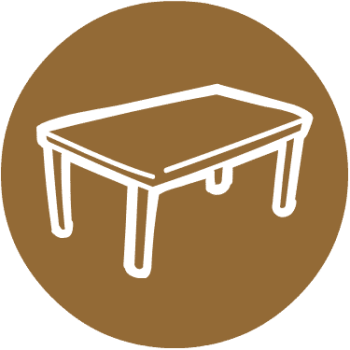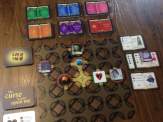| Release Date: 2025 | Players: 2-5 |
| Designer: Jessica Metheringham, Mill Valentine | Length: 15-30 minutes |
| Artist: Jessica Metheringham, Samantha Grieve | Age: 8+ |
| Publisher: Dissent Games | Complexity: 2.0 / 5 |
| Plastic (by weight): unknown | Air (by volume): unknown |
Working by candlelight, we carefully stepped between endless shelves of books, books whose vivid imagination and terrible thoughts had become real and had entered our world. There were giant kraken, the frightful Fenrir and other monsters, as well as infamous characters, such as Count Dracula or Grendel’s Mother, prowling in the shadows. However, luckily, wonderful women, such as Marie Curie, Anne of Green Gables and even Red Riding Hood, had also come to life. With the help of these powerful heroines, we could finally catch those creatures that were Loose in the Library by Mill Valentine and Jessica Metheringham from Dissent Games with art by Samantha Grieve and Jessica Metheringham.
Listen to the Audio Version
Intro Music: Bomber (Sting) by Riot (https://www.
Music: Halloween Atmosphere 2018 (endless loop) by Sascha Ende
Link: https://ende.
Music: Dreamsphere 4 by Sascha Ende
Link: https://ende.
I always love the imagination and creativity that games from Dissent exude. As another game set in the same world and using the same amazing art style as its spiritual predecessor, Library Labyrinth, Loose in the Library follows a different path. You no longer work together to return the escaped horrors as you work your way through an ever-shifting maze of bookshelves. Instead, you all compete to catch the most monsters with your hand of heroines. You also compete to complete shared and your personal objectives for extra points.
Otherwise, though, the game will feel very familiar to you if you have already played Library Labyrinth. The symbology is the same, the art style is the same, and the basic principles are the same. However, Loose in the Library is still a very different game, not only because it’s competitive.
Loose Start
When you first open the box, you will see the large number of cards the game comes with. I’ve only played a late prototype of the game, but I can already tell how much amazing artwork there will be. There are a number of decks, representing the horrors, your heroines, as well as the personal and shared objectives. That might feel a bit overwhelming, but Loose in the Library‘s rulebook is really clear.

Get yourself a wooden Tabletop Games Blog dice tray.
Each tray is the perfect size to roll your dice, and with the soft mat, it’s really quiet, while the wooden frame makes it wonderfully sturdy.
Not only that, the game also tries to ease you into everything. It’s divided into different chapters, which makes it feel a bit like a campaign game, but in reality, the game starts with the basic rules and each subsequent chapter adds something new, until you end up with the full game.
I love that.
It’s a similar approach to how video games ease players into their world. Loose in the Library starts simple. Chapter 1 gives you just enough rules for a satisfying first game, without overwhelming you straight away. The game ramps up until, in the last chapter, you end up with a really deep game where you have lots of decisions to make.
Of course, you can stop at any point. If you prefer, just use the rules included up to chapter 3. You can adapt Loose in the Library to your liking that way. That’s amazing. It’s almost like you have a difficulty level setting that you can change based on how you feel on the day or depending on the people you play with. You can jump straight in at the highest difficulty, or you can start easy – or anything in between.

Library Shelves
Now, I still haven’t told you how Loose in the Library works. Ultimately, it’s a set collection game. The heroine cards that you draft have a combination of symbols on them. If you can match the symbols from one or more heroine cards with those printed on a single horror card, you discard the heroines and pick up the horror card for points. The symbols are sort of like resources that you have to pay to “buy” the monster.
Additionally, players have personal objectives to complete to gain even more points. These are counted up at the end and are often based on the types of horror cards you have. There are also shared objectives visible to everyone. As soon as a player has met a public objective’s requirements, they can claim that card for one-off points. These are often about having certain heroine or monster cards.
On your turn, you can take two actions. You can draw heroine cards, catch monsters or even discard cards to get new personal objectives. As the chapters progress, there are more things you can do, but I don’t want to spoil anything.
However, with these basic rules, you already have a really interesting game with plenty of decisions to make. You need to decide when it’s time to draw more heroine cards, when to discard them to claim a horror or when you might keep them to work towards an objective. You also need to keep an eye on the other players to gauge what creature they might be going for. Already, Loose in the Library gives you plenty to think about. There is plenty of interest here for a game that lasts around 20 minutes, and as you go through the chapters, the game adds more options that require more thinking.

Heroine Huntresses
What makes this game even more interesting, though, is that it is about women. I intentionally said heroine throughout my review. Loose in the Library does an amazing job of celebrating real and fictional women from history. As you play, you learn names that are otherwise rarely mentioned. Additionally, the game was designed and illustrated by women. It’s a game by women, about women – but not just for women, of course.
That is not to say that Loose in the Library doesn’t stand up to other games in the genre. In fact, I think it stands out from other games not for the focus on female figures, but because of how you learn it. It’s the first game I’ve come across where you can pretty much start playing after five to ten minutes of learning the rules. Once you have played a couple of games, you can move on to the second chapter to introduce a couple of new mechanisms. I was able to get people, who aren’t particularly familiar with modern hobby games, to play Loose in the Library within minutes using the rules of the first chapter. Not only that, after a few turns, they got it and really got into it.
So, yes, we should celebrate the women from history, and Loose in the Library does this really well, but being able to learn and teach a game so quickly and then having a really satisfying and fun gameplay experience is absolutely amazing.
You know what I’m going to say. If you like competitive set collection games that are easy to learn, then definitely check out this game. If you are interested in learning more about powerful women from our past, then you have even more reason to see what Loose in the Library is all about.
Keeping the blog running takes time and resources. So if you can chip in, that would be amazing.
Useful Links
- Loose in the Library: https://dissentgames.
com/ litl/ - Kickstarter page: https://www.
kickstarter. com/ projects/ dissentgames/ loose-in-the-library - Dissent Games: https://dissentgames.
com/ - BGG listing: https://boardgamegeek.
com/ boardgame/ 431171/ loose-in-the-library - Library Labyrinth review: https://tabletopgamesblog.
com/ 2022/ 02/ 26/ library-labyrinth-saturday-review/
Transparency Facts
- I was given a free review copy of this game by the publisher.
- At the time of writing, I have not received financial support from the publisher or anyone working on their behalf.
Audio Version
Intro Music: Bomber (Sting) by Riot (https://www.
Music: Halloween Atmosphere 2018 (endless loop) by Sascha Ende
Link: https://ende.
Music: Dreamsphere 4 by Sascha Ende
Link: https://ende.
Playlist
These are the songs I listened to while I was writing this review:





